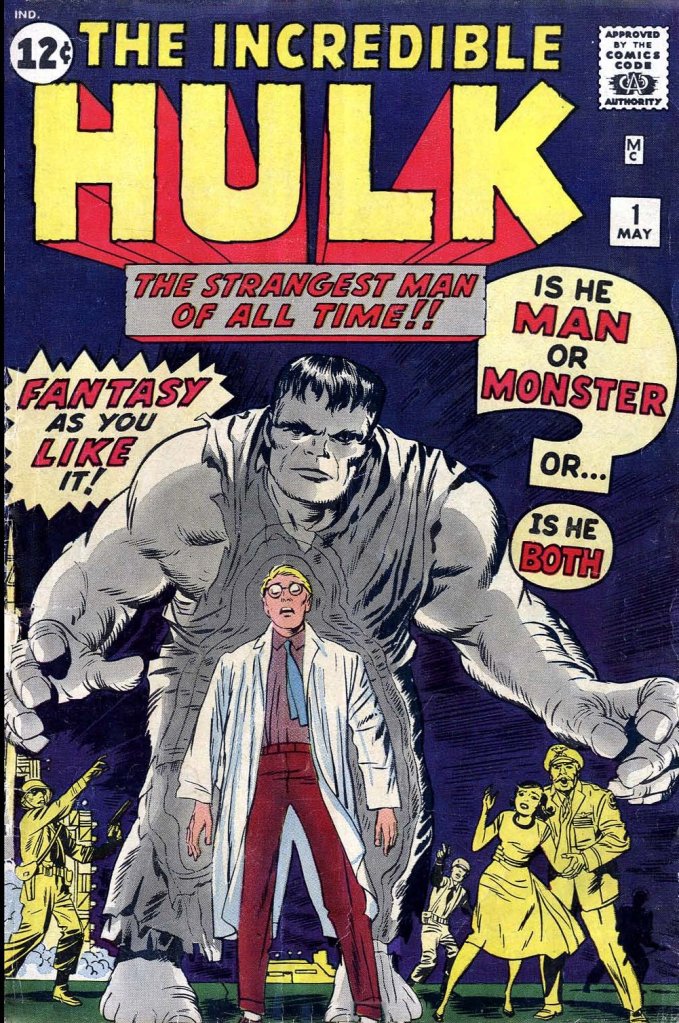
From the vantage point of hindsight, we view the Hulk as a super hero, the second in a string of new creations unleashed in the earliest years of the 1960s on an unsuspecting public, the building blocks for what would become known as the Marvel Universe. But that’s really an impression that has been colored by having the character spoken about in those terms ever since he caught on. But if you look at the earliest issues of the series, while it shares some similarities with a super hero title (and, in fairness, Marvel was only just starting to work out what a super hero title was to them) it is much more clearly a monster series book in the vein of Dick Briefer’s FRANKENSTEIN from the Golden Age, or the Heap in AIRBOY COMICS. And of course, INCREDIBLE HULK was a failure when first launched, the title only lasting for a scant six issues. Had Lee and Kirby not brought the character back a couple of months later as the catalyst for launching AVENGERS, it’s doubtful that anybody would remember him any more distinctly than any of the other oversized monsters that littered the pages of the assorted Marvel fantasy titles before the super heroes came and took them all away. So what I propose to do here is a brief survey of those initial six issue.
So we know a couple of things going into this. Over the months leading up to the launch of INCREDIBLE HULK #1, Kirby alongside Lee and Larry Lieber had been producing a series of one-off stories featuring colossal monsters, threats to mankind taken right from the monster feature films of the late 1950s. These ran the gamut, but in devising a broad spectrum of approaches to the question of building a headlining creature every month, Kirby worked on two or three stories that revolved around the notion of a regular person being transformed temporarily into a raging monster. One of these, “The Midnight Monster” in JOURNEY INTO MYSTERY #79, apparently inspired Jack Kirby to put forth the idea that, rather than inventing a new monster every month, they take the core idea of that story–a Dr. Jekyll/Mister Hyde monster who would transform from a regular person into a monster and back, and instead do a series around the character. If nothing else, this would limit the number of times that Kirby would need to reinvent the wheel every month, coming up with new wrinkles on the monster format.
Additionally, as researcher and sometimes Kirby-cohort Greg Theakston once pointed out, by 1962 there was something of a monster boom happening in the world of popular culture. B-movies built around strange monster menaces were a regular feature at the nation’s drive-ins, and the release of the classic Universal Horror Films in syndication to television created a new generation of fans to come together. This interest led, among other things, to the publication of FAMOUS MONSTERS OF FILMLAND, as well as any number of rival magazines attempting to tap into the same fad. So why shouldn’t Marvel get in on the action?
Marvel publisher Martin Goodman clearly thought that there was something to this idea, regardless of who may have come up with the initial impetus for it. Marvel was at that point still limited in the number of titles it could release every month, but rather than trying the feature out in one of the ongoing monster titles, Goodman instead decided to launch the Hulk in his own self-titled magazine. I’m guessing that good initial returns on that JOURNEY INTO MYSTERY issue may have encouraged him in this direction. Editor and scripter Stan Lee and artist and plotter Jack Kirby invented Bruce Banner, who would be caught in the explosive discharge of his experimental Gamma Bomb, the radiation from which would cause him to transform into an unstoppable juggernaut whenever the sun would go down.
It’s been widely reported that the Hulk was colored gray in this first appearance by mistake, or in a case of poor judgment. Theakston, though, had a different theory. Given that the Universal films were in black and white, as were virtually any television on which they might be watched, he suggested that the gray color was to help liken the Hulk to the monster of Frankenstein. In color photographs, the Frankenstein monster was being colored with green skin, but that wasn’t the way in which most viewers of the period saw him. I don’t know that there was any deep thought given to the Hulk’s color, but that’s as good a theory as any. Another is that it plays into the concept of this early strip, with the Hulk’s dark shade suggesting the notion that he would emerge only when the sun went down.
By the second issue, already aspects of the character had begun to change–most notably, his coloring. This strikes me as a relatively late-in-the-day change, as the shift in the Hulk’s color scheme isn’t so much as commented on. Compare this from when Iron man went from red to gold, which got an entire scene to set up and establish the change. This issue reads as though the Hulk has always been green. Given what was to follow, I wonder if this wasn’t a move on the part of Martin Goodman to attempt to goose sales on the title. From context and what follows next, we can intuit that the initial returns on INCREDIBLE HULK #1 were disappointing, and either Goodman or Lee may have felt that giving the Hulk a poppier color scheme than dull gray might help to make him more appealing on the stands. Theakston once conjectured that the change may have been in response to some legal sabre-rattling from the Universal rights-holders, but that seems like a stretch to me. And if it was, why would you make the Hulk’s coloring green, and even closer to that of Frankenstein?
Otherwise, the story again isn’t’ anything that you would recognize as a super hero adventure. If anything, the Hulk is a spoiler character who winds up causing more problems, and who seems at any moment likely to turn against the human race, a greater danger perhaps than the alien Toad Men who are invading. It’s the Hulk’s alter ego Bruce banner who, along with his friend and sidekick Rick Jones, proves to be heroic here, pitting his intellect against the invaders and finding a way to send them packing, all while hampered by the rampages of his alter ego. In not having to start at square one, Lee and Kirby are thus able to begin adding some dimension to both Banner and Jones as well as the rest of the small cast, including the Hulk’s military nemesis General “Thunderbolt” Ross and Banner’s romantic interest Betty Ross, the General’s daughter.
It’s also a really good looking issue, with Kirby’s pencils inked by artist Steve Ditko. This represents Ditko’s first point of contact with the character. Ultimately, it would be he who, after a few years of trial-and-error, would crystalize the idea that Banner turned into the Hulk whenever he got angry or was placed under stress. But here, his subtle, creepy ink line complements the power of Kirby’s penciling, retaining all of its power but adding a subtle sense of paranoia into the mix. Kirby inked by Ditko was always a potent combination, and it’s only the fact that Ditko was so much more valuable as a penciler and plotter himself that kept it from happening more often.
By the time INCREDIBLE HULK #3 comes out, there’s a sense of trouble on the horizon. Because for no particularly discernable reason, Lee and Kirby take it upon themselves to totally retool the series at this point. Tellingly, the issue no longer features a single book-length story (albeit typically broken up into individual chapters as was the Marvel style of the era) but rather two shorter Hulk adventures, bridged by a short retelling of the character’s origin. This suggests to me that Goodman’s disappointment with the book’s performance was relatively strong, and so the stories were made shorter so that they could more easily be repurposed as inventory in other titles should the series be cancelled–as I believe it may have been.
As the cover touts, and despite the fact that scripter Stan Lee attempts to disguise and explain away the depictions of this power as simply enormous leaps, plotter and artist Jack Kirby gives the Hulk the attribute of unassisted flight in this story. Kirby would continue to depict the Hulk as capable of unaided flight through the end of his tenure on the title and even throughout the early issues of AVENGERS.
More crucially, the conceit of Bruce Banner transforming into the Hulk after dark is entirely tossed aside in this story. After General Ross tricks Rick Jones into luring the Hulk into a space capsule as a way of getting rid of the monster, the brute is eventually bombarded by cosmic rays of the sort which empowered the Fantastic Four. Jones happens to be in contact with the control panel at this moment, which results in a psychic connection being forged between himself and the monster. When the Hulk comes crash-landing back on Earth again, he maintains his Hulk form at all times–Bruce Banner is effectively dead. What’s more, the Hulk himself isn’t doing all that well either, despite his new aeronautic abilities. Thanks to their connection, the Hulk becomes virtually mindless whenever Rick Jones is awake and in his proximity. The brute becomes in effect a robot operated by Rick Jones and subject to his commands. In this manner, he presages the Japanese series Tetsujin 28, which would shortly hereafter air in the United States under the title Gigantor.
The second story in this issue comes the closest to resembling a super hero adventure, though again, the hero here isn’t so much the Hulk as it is Rick Jones, the boy who commands him. Kirby reaches into his past and resurrects a concept from one of the earliest Captain America stories produced by himself and then-partner Joe Simon, the criminal Ringmaster and his Circus of Crime. He’s a master hypnotist who attracts large crowds to his carnival shows, then mesmerizes them, allowing his troupe members to loot entire cities. But when Rick Jones falls victim, his paralysis isn’t enough to prevent him from mentally summoning the Hulk to demolish the Circus and put a stop to their malicious behavior. If the lead story in this issue was about transitioning the strip to the new model, this second story was effectively the pilot episode of the new format. But it wouldn’t last long.
A few years back, write and artist Larry Lieber, coincidentally Stan Lee’s younger brother, revealed that he had saved the discarded pages for a Hulk story from this era for fifty years. According to Lieber, he was present in the Marvel offices the day Jack Kirby arrived with the story in hand, and he was also there when Kirby angrily left editor Lee’s office, tore the pages in two and discarded them in a wastebasket–from which Lieber saved them, him being a fan of Kirby’s work who possessed a desire to study it.
Since this came to light, there have been all sorts of theories about what may have caused this event to happen–many of them casting Lee as the clear villain here, causing Kirby to discard and destroy a week’s worth of work. And that may be possible. But I have a different theory as to what likely happened at this point. It’s clear from context that the story in question had been intended for INCREDIBLE HULK #4, as it follows the new format to a T. In the pages which survive, we can see that criminals are planning to fix a high school basketball game that Rick Jones is playing in, by substituting their own men for the opposing players. While he for some reason is laid up in a hospital bed suffering from a head wound of some kind, the Hulk once again responds to Rick’s mental summons, and he uses his prodigious strength at Rick’s command to destroy the thugs’ plans. There’s really no other place chronologically that this story could fit into the run of INCREDIBLE HULK–it was intended for issue #4.
Years later, in 1982, Jack Kirby gave an interview to Will Eisner which appeared in the 39th issue of Kitchen Sink Press’s THE SPIRIT Magazine, which reprinted Eisner’s classic series from the 1940s. In it, he talks about INCREDIBLE HULK being cancelled with its third issue, and thereafter being saved from the axe by a missive from some college students who had adopted the character as the mascot of their dorm. Most people, myself included, reading this comment at the time assumed that Kirby simply got the issue number wrong–that he was remembering that the series had been discontinued early on, but not exactly when. But I suspect that he may have been righter than he seemed.
My guess–and it’s only a guess–is that Martin Goodman pulled the plug on INCREDIBLE HULK after issue #3, at least for a short period of time. The reason Kirby was so angry stalking from Lee’s office and why he destroyed that story was that Lee had informed him of Martin’s decision. It’s possible that Kirby’s account of what changed Goodman’s mind is also accurate, though I wonder if early returns on issues #2 and #3 may have shown more life in the book than was first apparent. Goodman tended to have a quick trigger finger when it came to cancelling underperformers in his line.
Immediately as INCREDIBLE HULK #4 opens steps are being taken by Lee and Kirby to retool the series yet again. Realizing that for all that it is fun to have the Hulk at his command, Bruce Banner is languishing somewhere inside the monster’s brutish form, Rick decides to expose the Hulk to additional gamma radiation from a device originally constructed by Banner. This has the result of giving the Hulk his mind and personality back–and what’s more, it’s the personality of Bruce banner, not his monstrous alter ego. In effect, Banner can now transform himself into the Hulk at will, whenever danger threatens. But when he’s the Hulk, his personality becomes a bit more bestial, more violent–in essence, more along the lines of the popular Thing from the team’s other series, FANTASTIC FOUR. This hardly seems to be a coincidence, especially if Lee and Kirby are attempting to save the book.
Like the prior issue, this one features two stories rather than a single book-long one. Again, I presume this was to help give Lee options for where the inventory could be repurposed and burned off if Goodman reversed his decision not to cancel. The first story is entirely devoted to undoing the status quo from the prior issue. The second story has the Hulk contend with Mongu, who on the surface seems to be an alien gladiator from outer space with monstrous strength, but who turns out, as so many of these early Marvel villains did, to be an agent of a communist power using a robot suit in an attempt to capture the Hulk for his superiors. It’s a pretty by-the-numbers story, even at this point, but it is relatively close to being a super hero adventure. The character is sliding in that direction slowly.
INCREDIBLE HULK #5 continues this pattern, with two more stories, both of which use the conceit that Banner operates a massive machine to bombard himself with gamma radiation and become the Hulk. A side effect of this process is introduced that suggests that if Banner remains in the Hulk’s form for too long, he will be unable to revert to his regular human self. This issue introduces one of the Hulk’s most recurring foes, Tyrannus. But still, he’s not really represented as a super villain so much as a Greco-Roman conqueror residing at the center of the Earth. Again, this idea was old hat to Lee and Kirby even at this point–they had already had the Fantastic Four face the similar Mole Man in their initial issue. Kirby does introduce his design for the denizens of the subterranean world in this adventure, which will be used again later as minions of the Mole Man just as often as they are of Tyrannus. The second story is another one in which the Hulk matches wits and fists with the red menace, this time in the person of General Fang.
The sixth and final issue of INCREDIBLE HULK featured a number of changes. Most obvious among them is that the story in this issue is a full-length epic, so presumably somebody was feeling relatively confident about the book’s future. It was also drawn and largely plotted by Steve Ditko, taking over for Jack Kirby. In an essay about his time at Marvel during this era, Ditko claimed that Lee had told him that he “didn’t want to waste Kirby on a failing title” and that’s why Ditko got the nod instead. It’s also the most overtly super-heroic story the character is in during this time, even though it again deals with an alien menace, the Metal Master, rather than any home-grown super-villain.
Ditko messes around with the Hulk’s transformations into Banner and back again a few different times in this story. Once, Banner comes out of the transformation with seeming strength and vitality, at least for a moment. When he tried to turn back into the Hulk, his head and face remain unchanged and he’s forced to disguise his features with a mask of the Hulk’s. And by the story’s end, the transformation seemingly fails completely, trapping Banner as the Hulk forever before, in his rage, he slowly reverts to his human form. This is as close as the original series ever gets to unlocking emotion as being the catalyst for Banner’s transformations–that won’t really fall into place until the Hulk gets his later solo series in TALES TO ASTONISH (which will also be largely plotted and drawn by Ditko, at least at the outset.)
There wasn’t anything in this final issue of INCREDIBLE HULK to indicate that it was being discontinued. In fact, a blurb on the last page exhorts readers to watch out for the next issue. But it seems as though numbers didn’t turn around enough to make permanent Martin Goodman’s stay of execution. Fortuitously–and likely motivated by a desire to try to turn some of their FANTASTIC FOUR audience into regular INCREDIBLE HULK readers–Lee and Kirby at the same time were guest-starring the Hulk and his cast in their popular flagship title. If nothing else, this cemented the Hulk into the nascent Marvel Universe, and made it far easier, I expect, to bring him back several months later as a founding member of the Avengers.

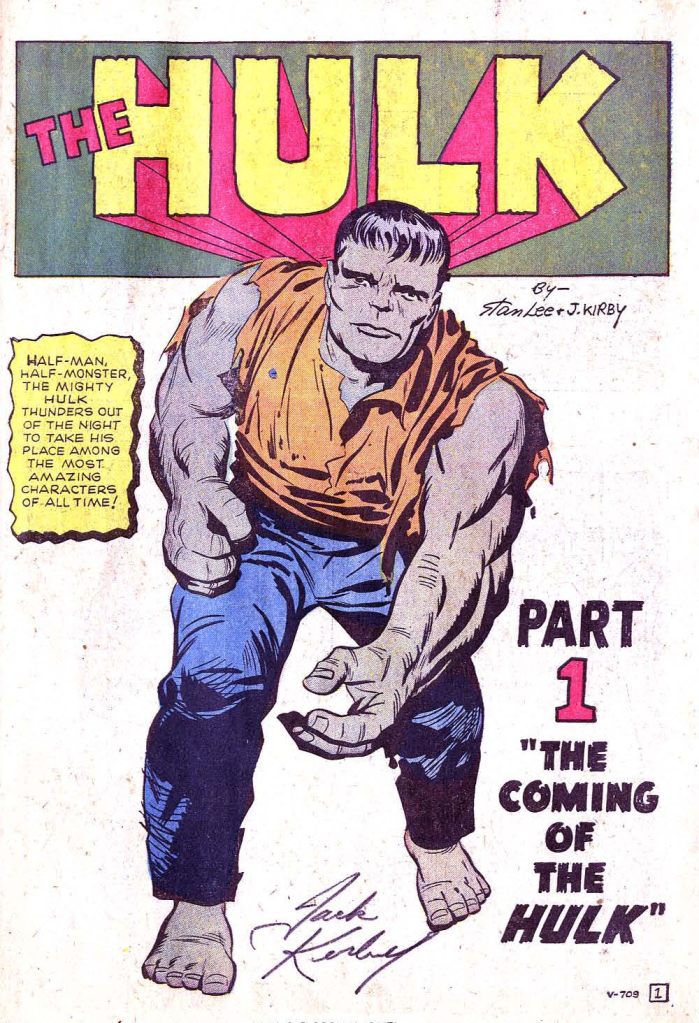
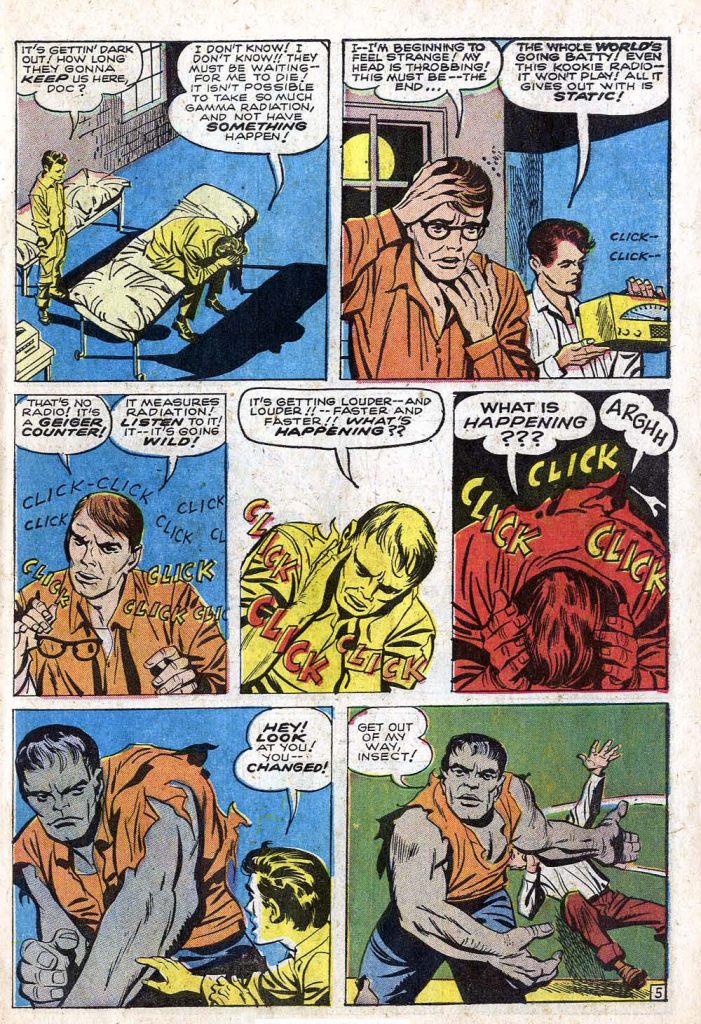
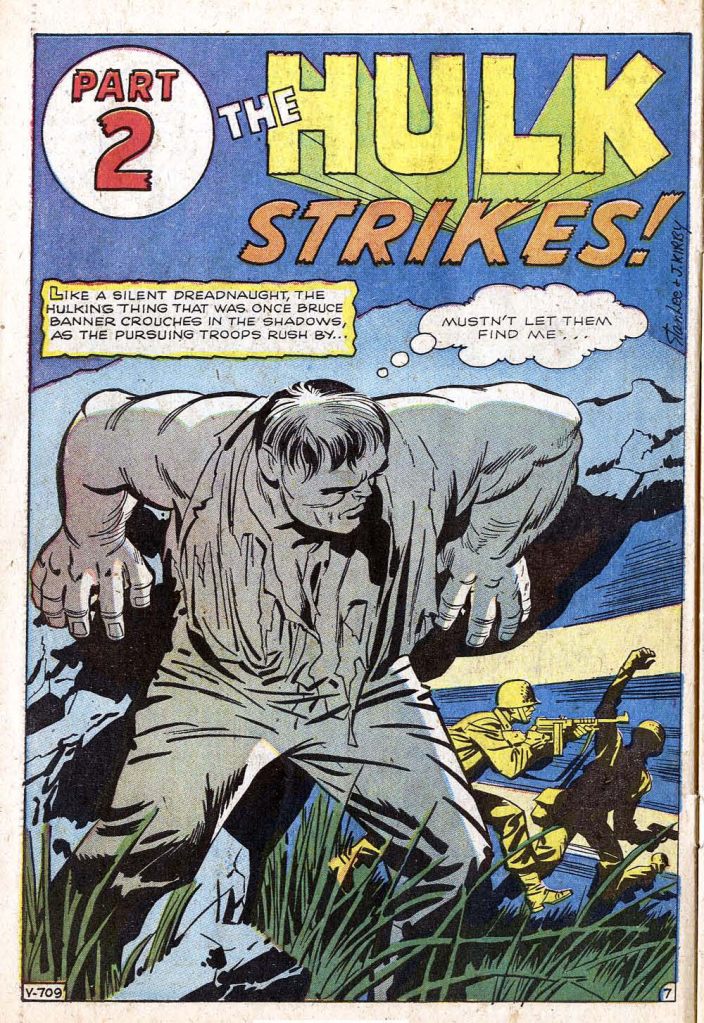

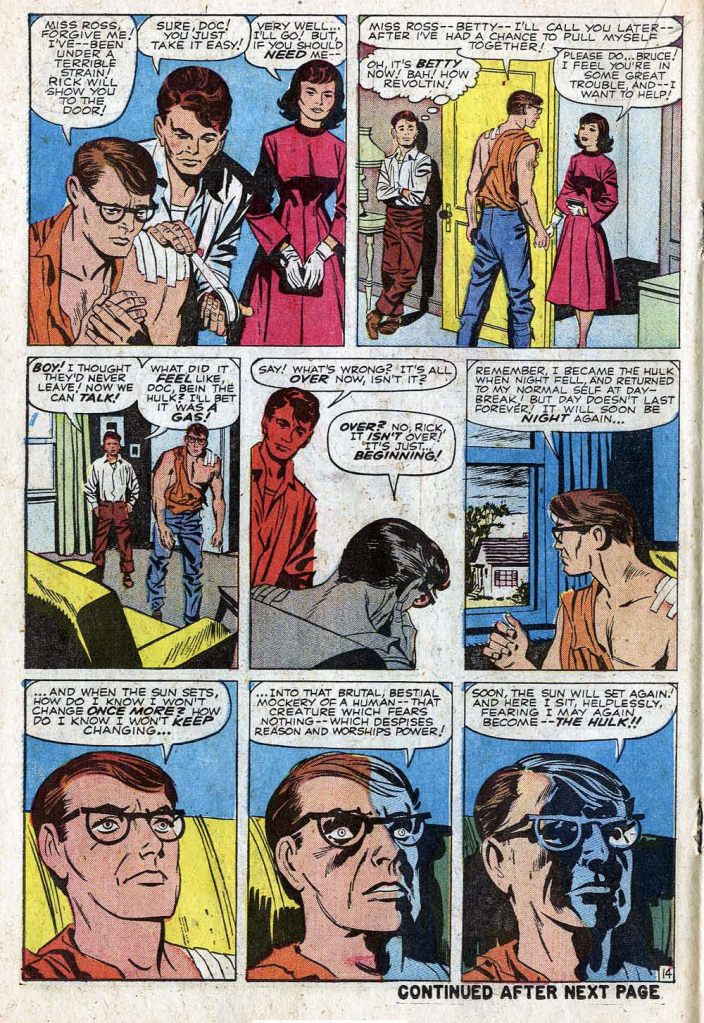

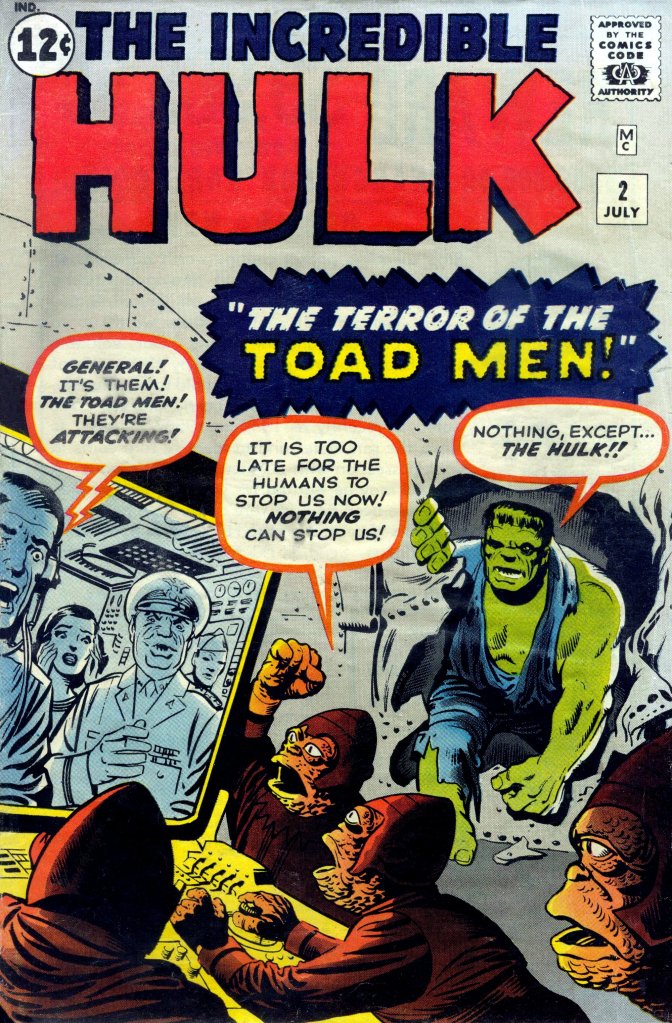

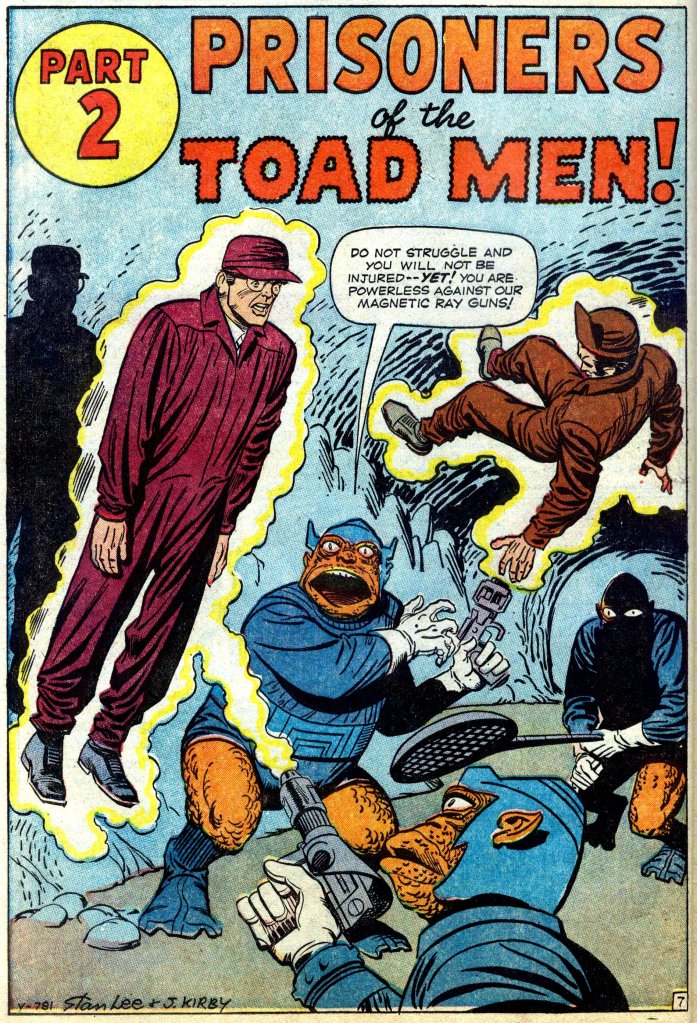
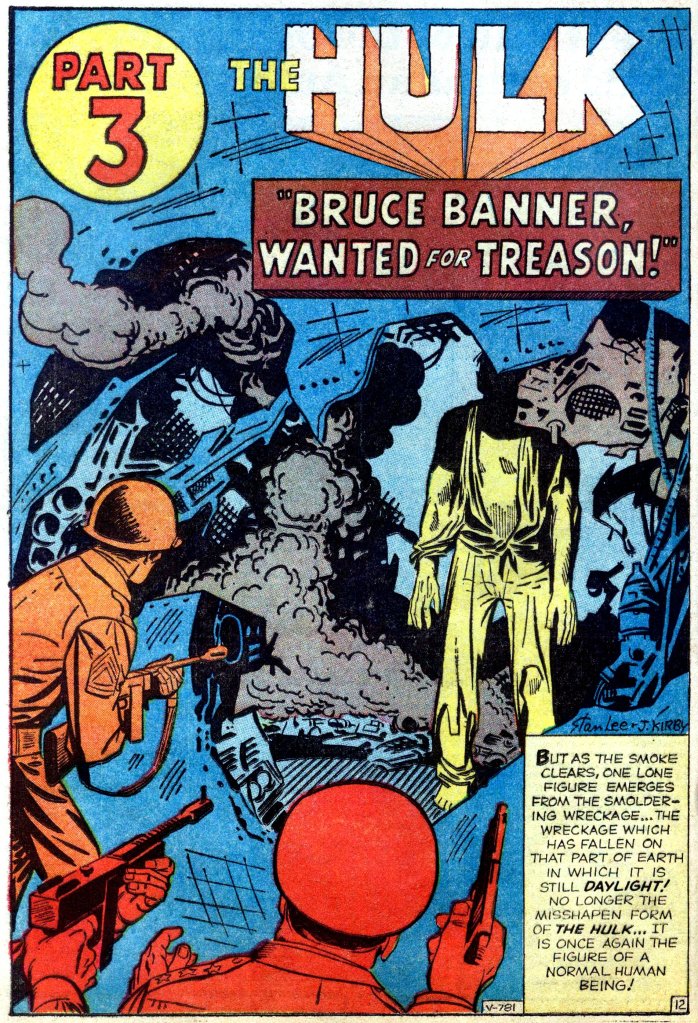
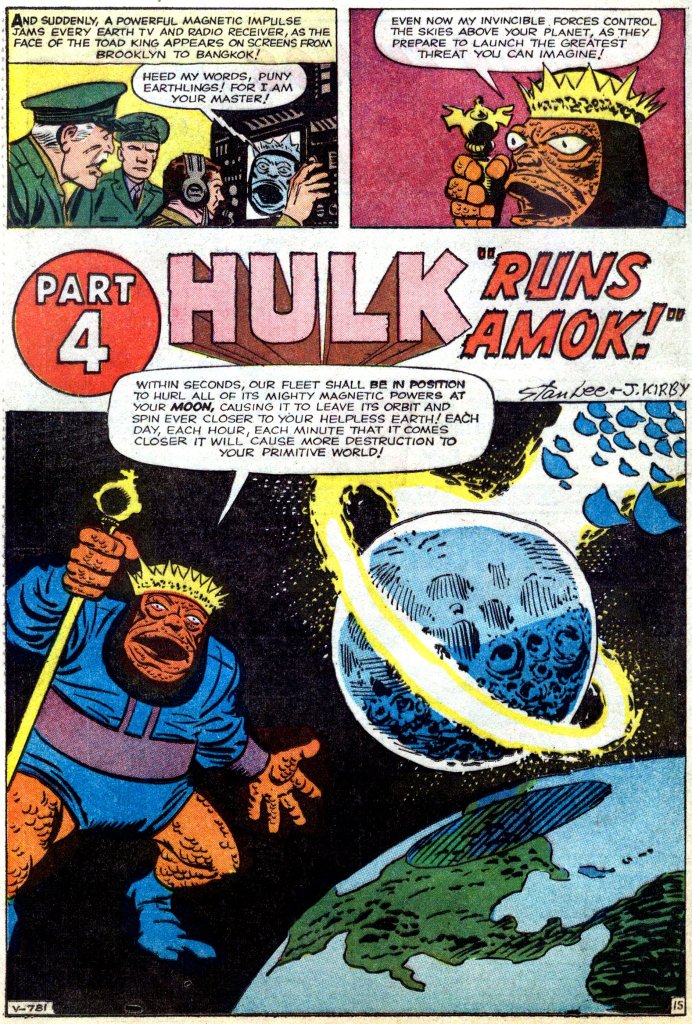
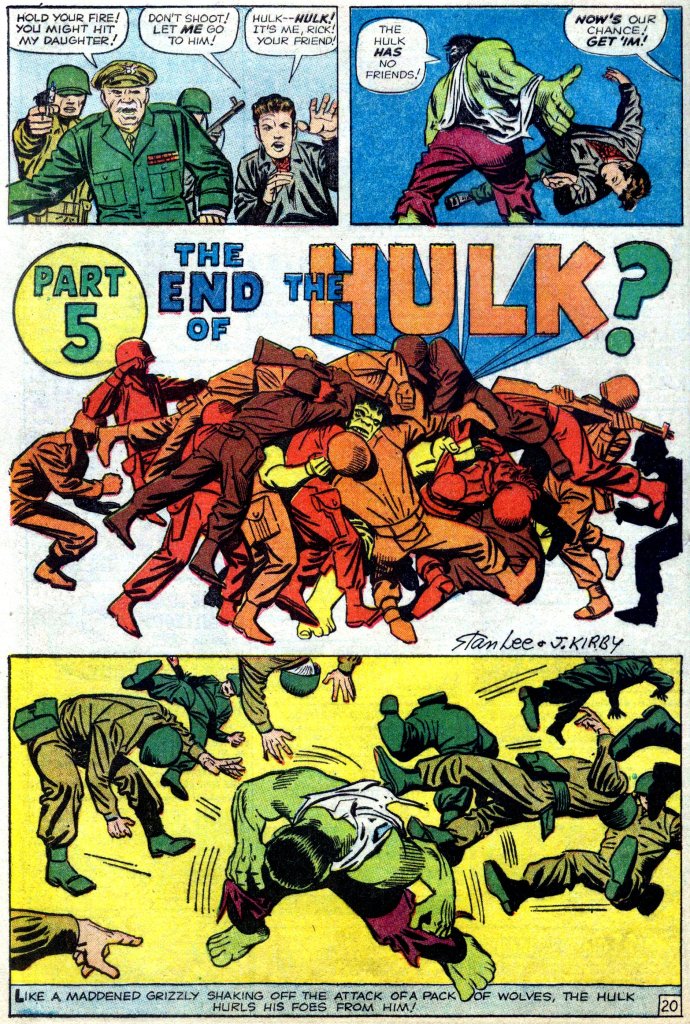
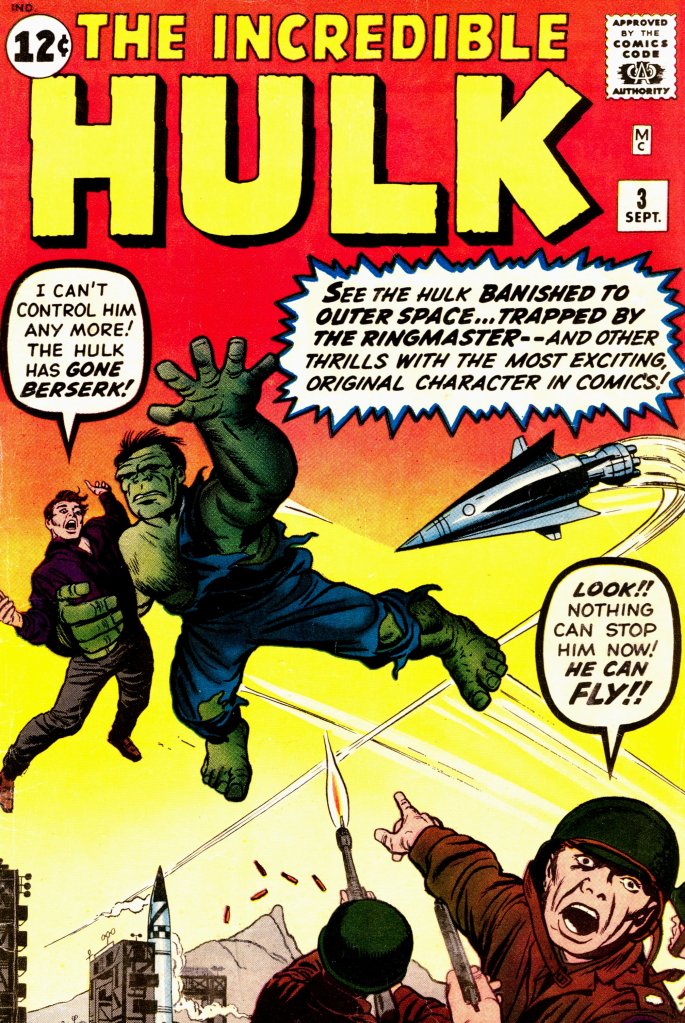
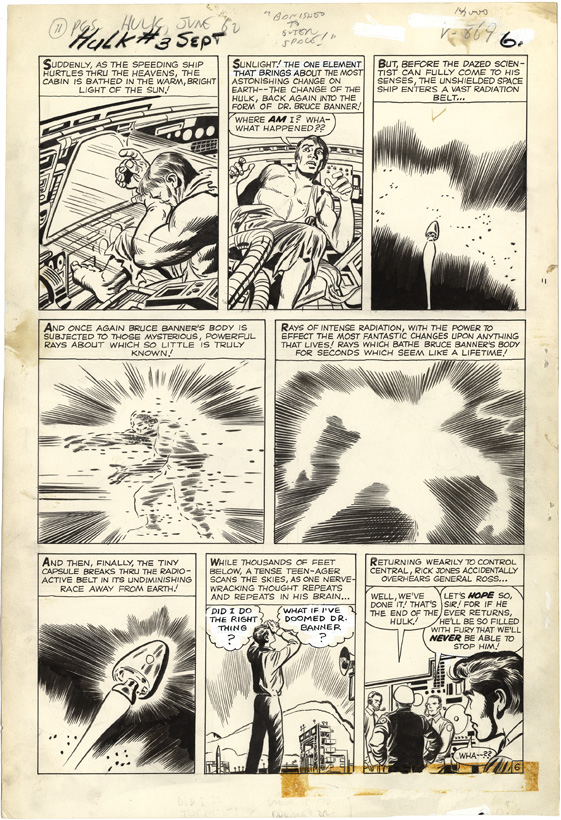
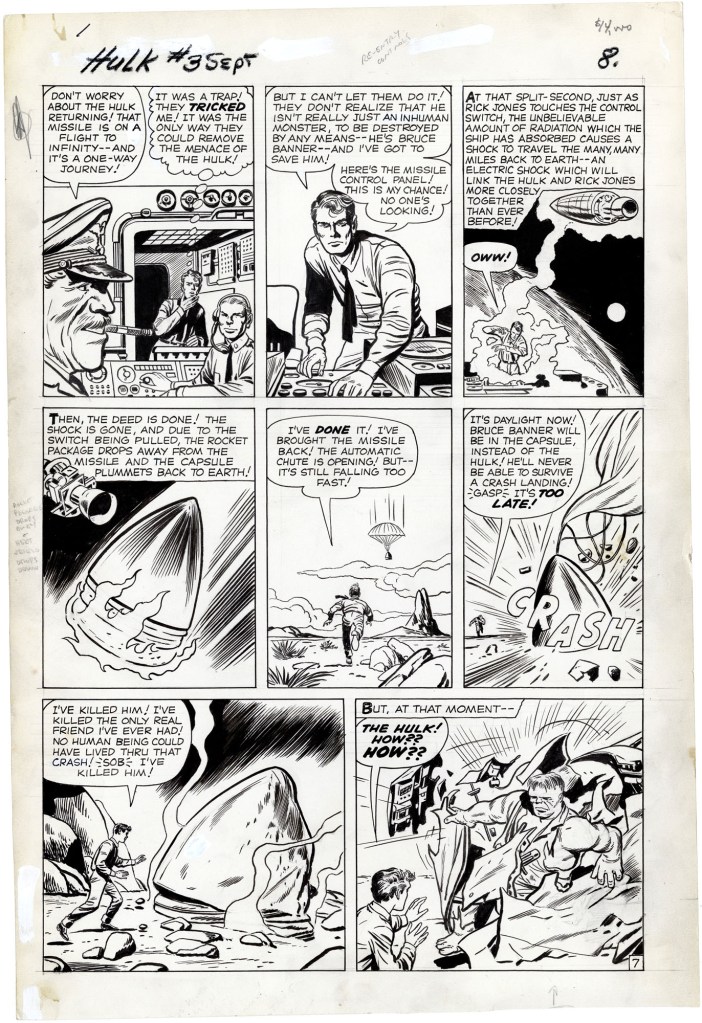
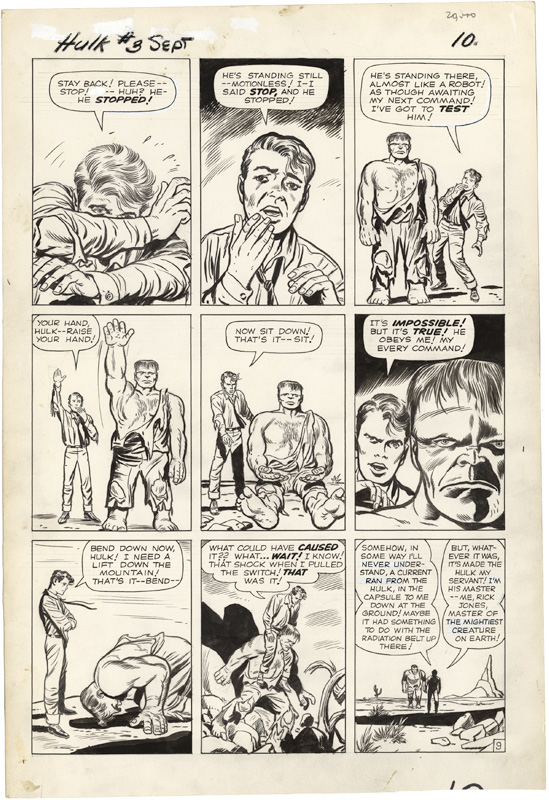

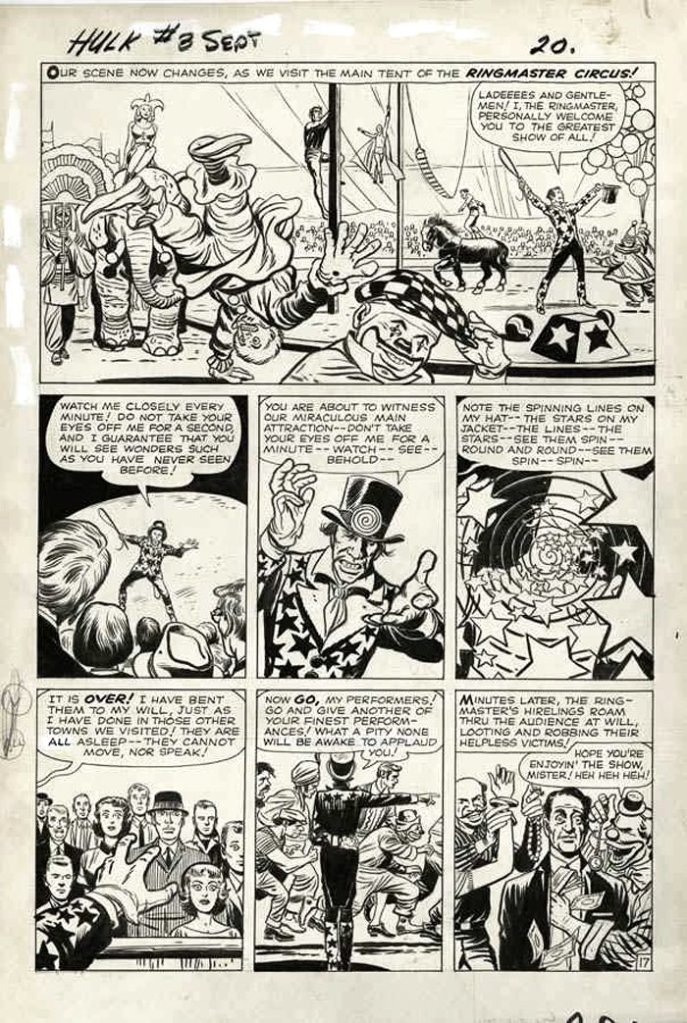
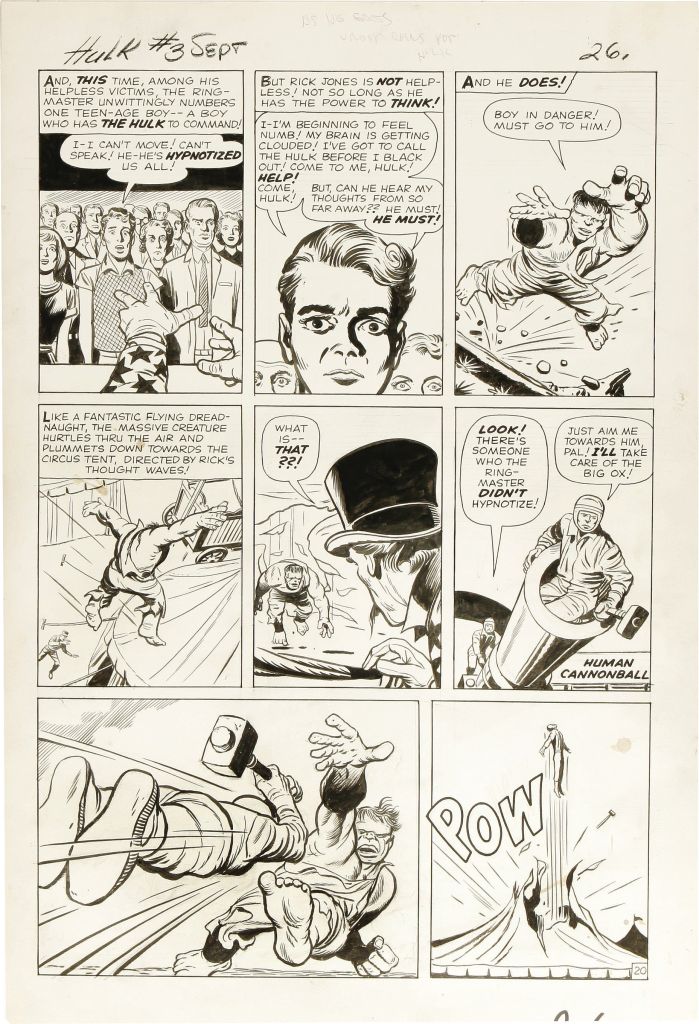



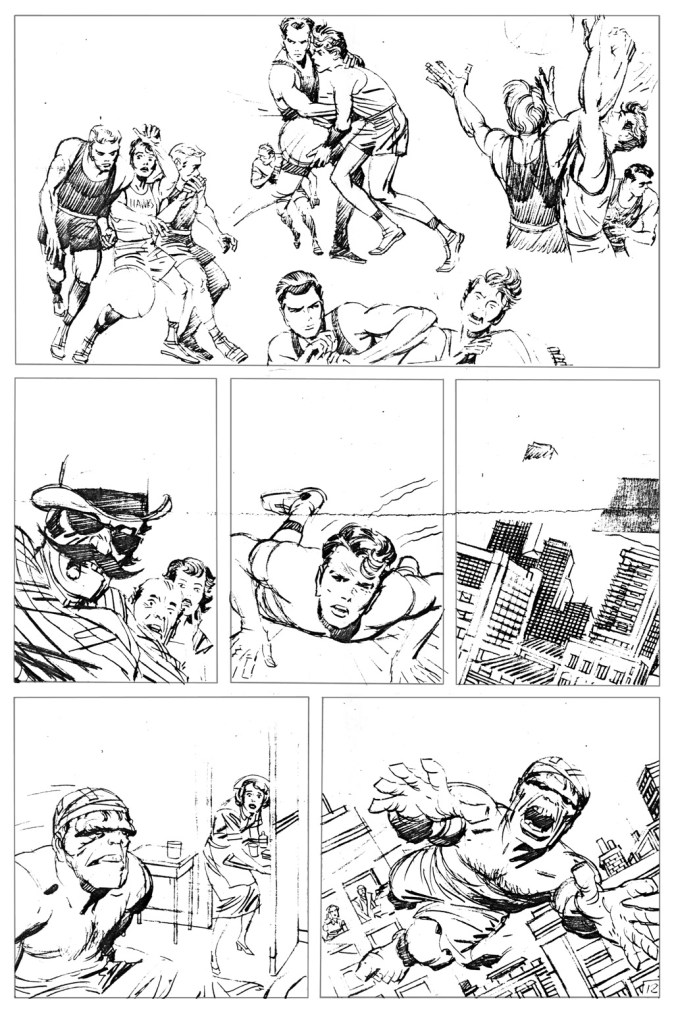
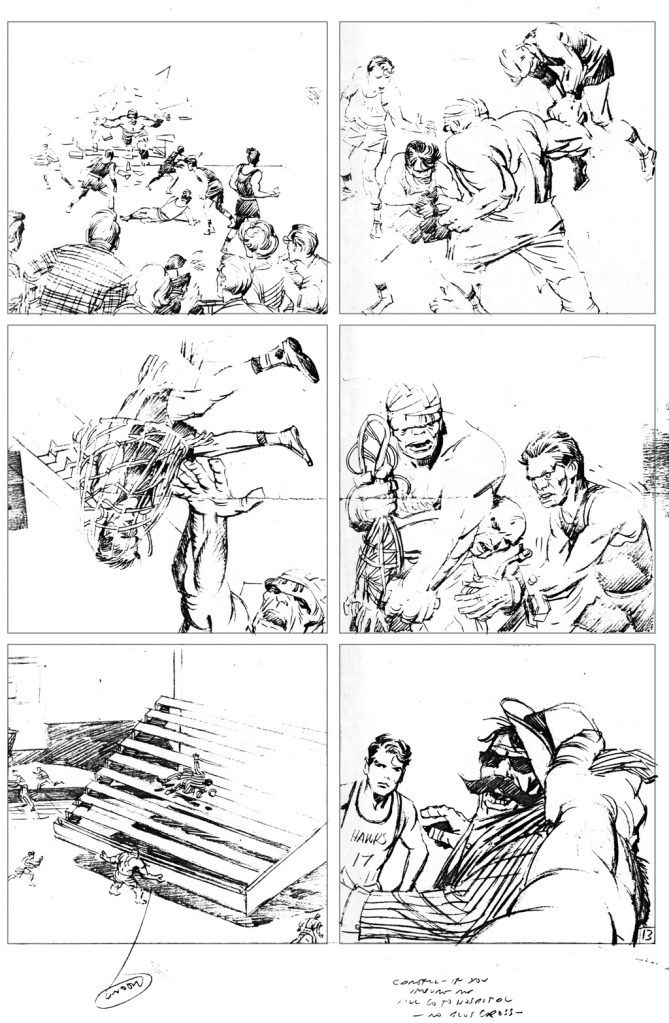
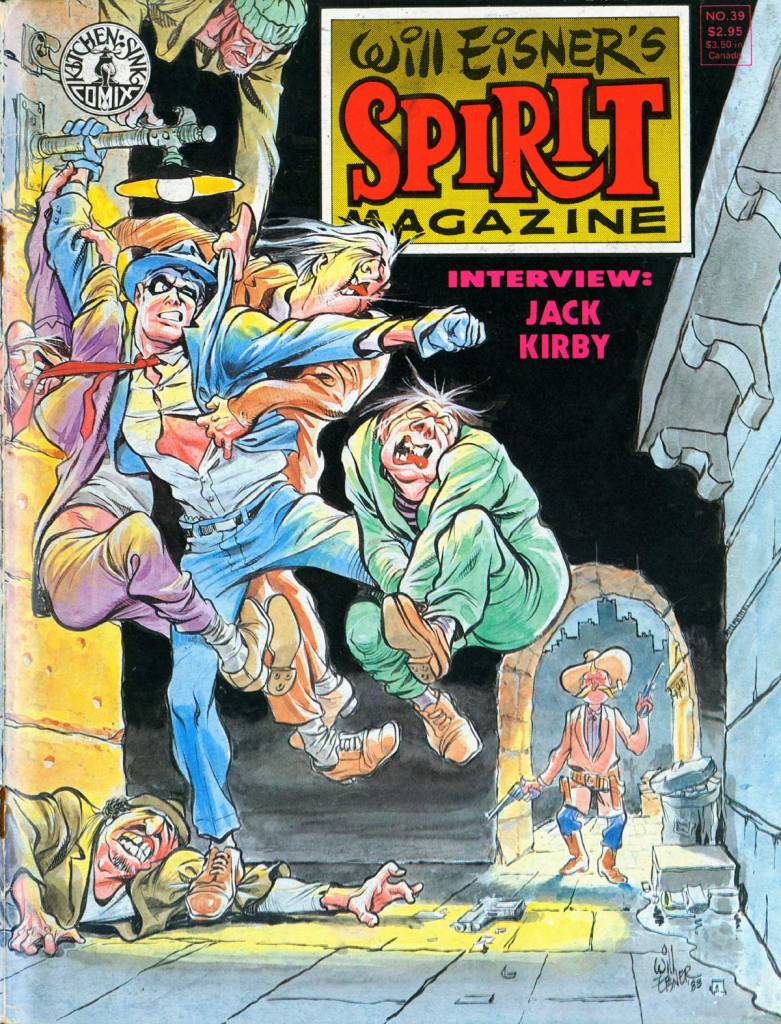
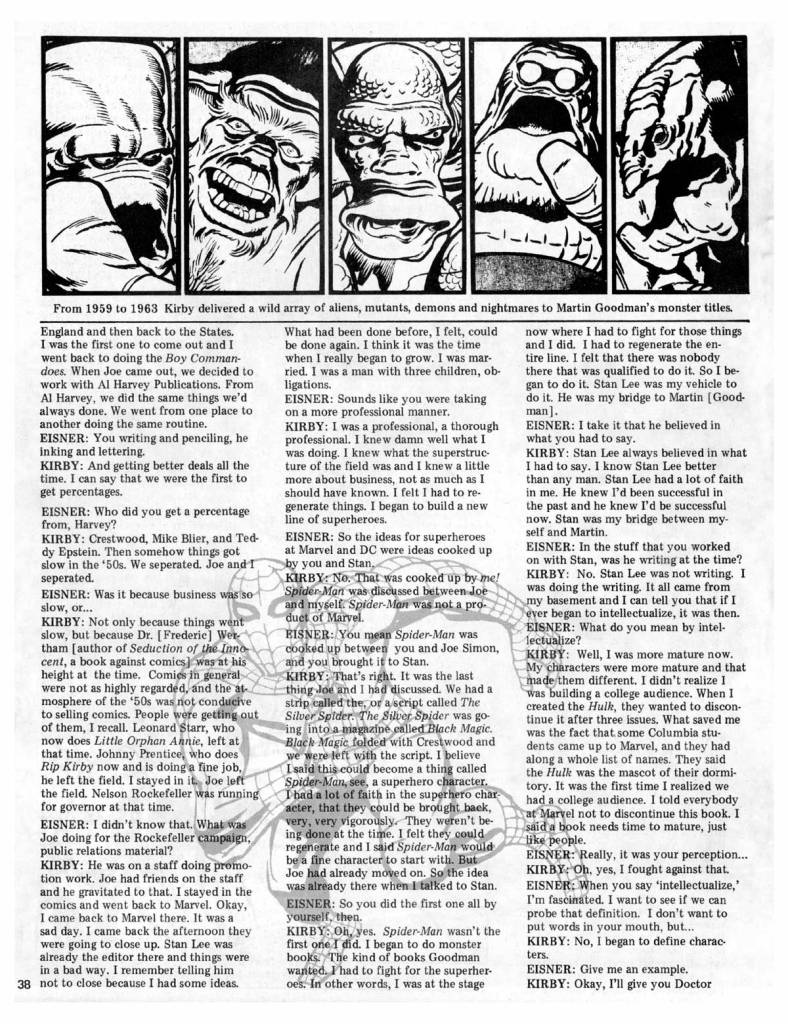
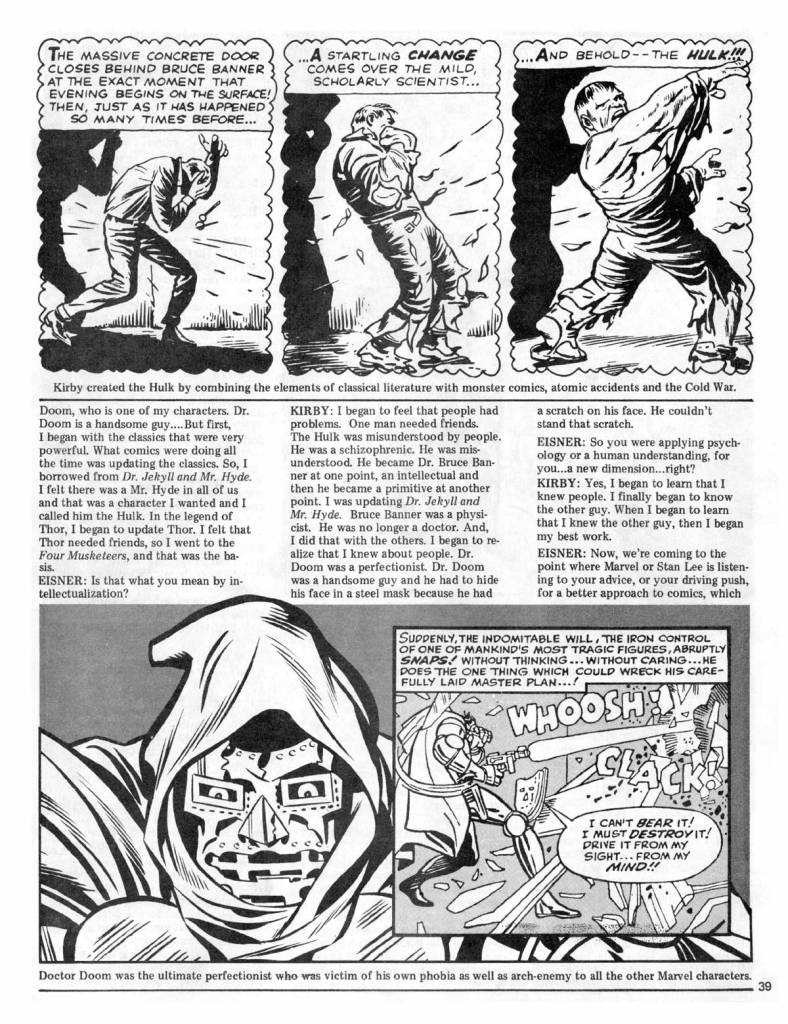
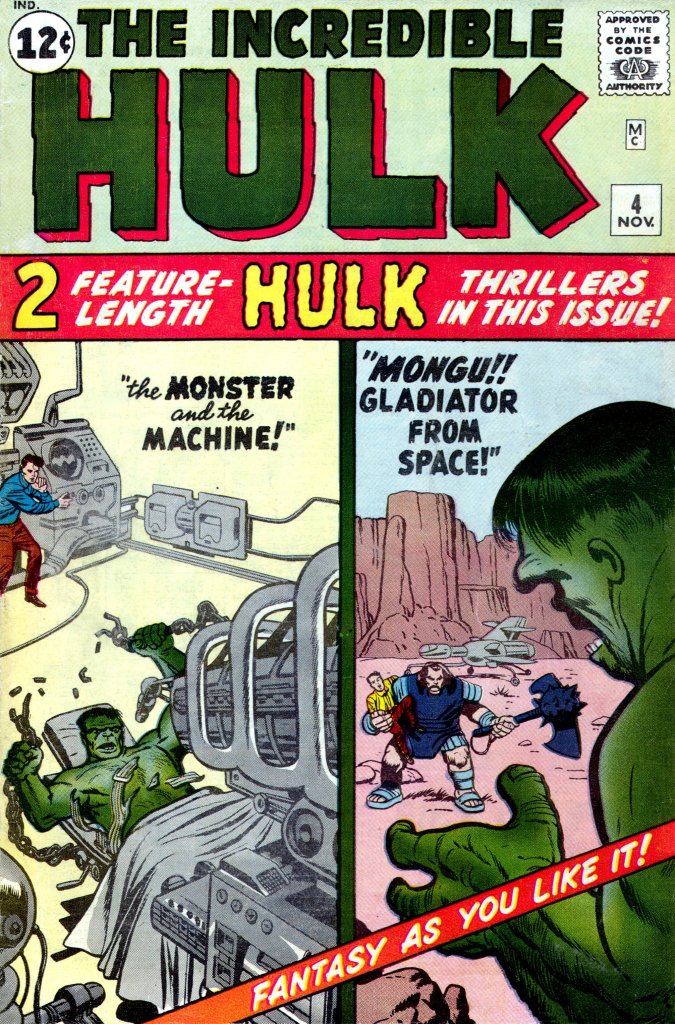

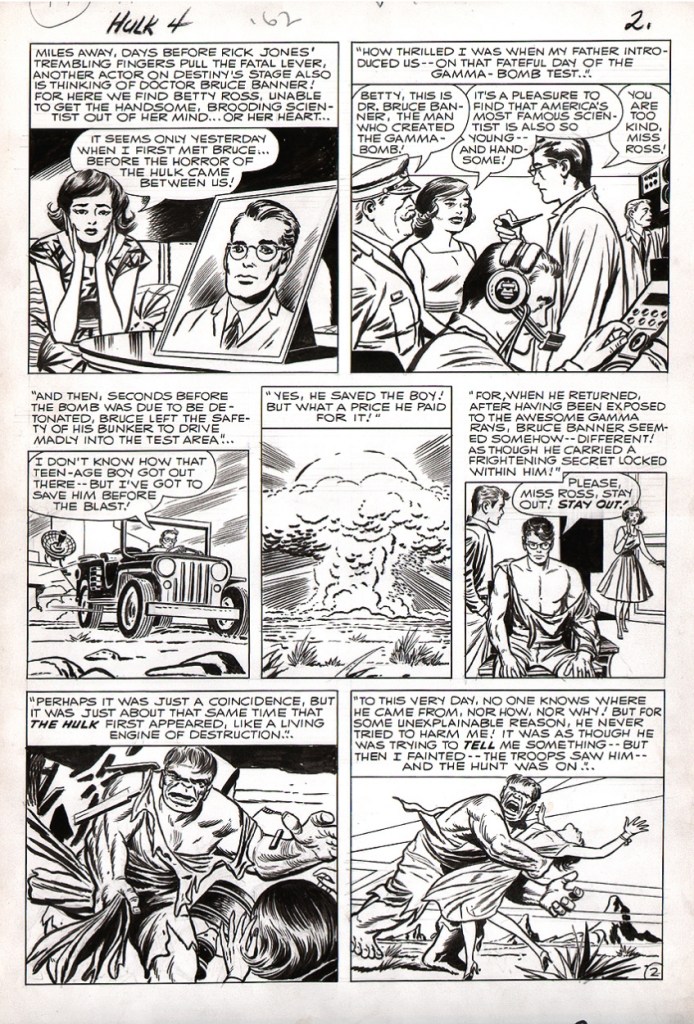
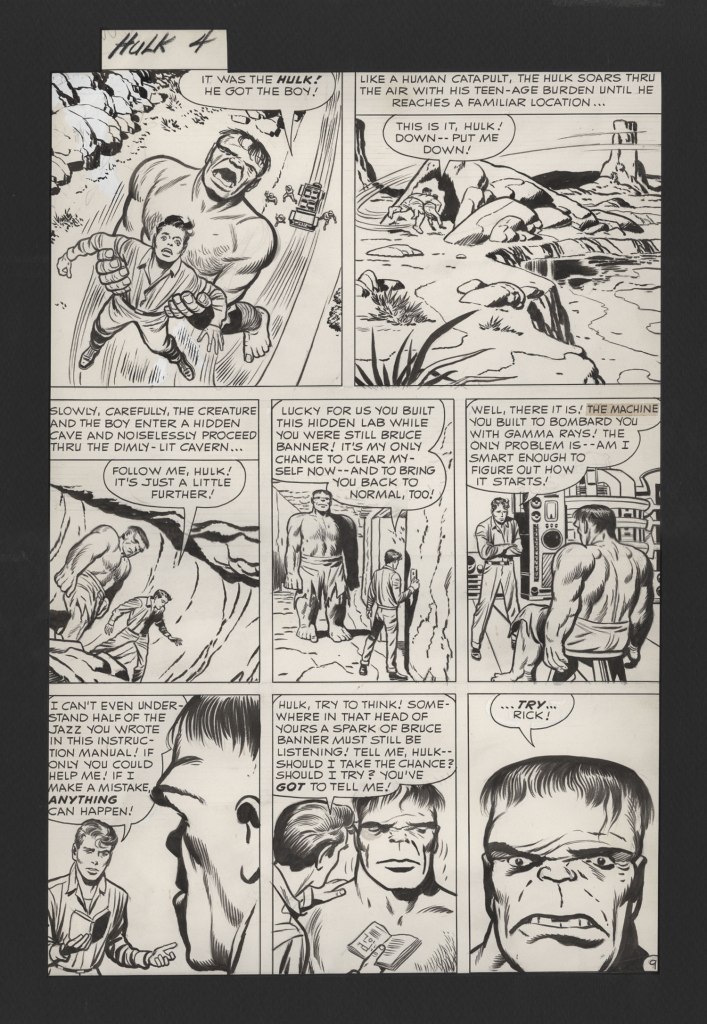
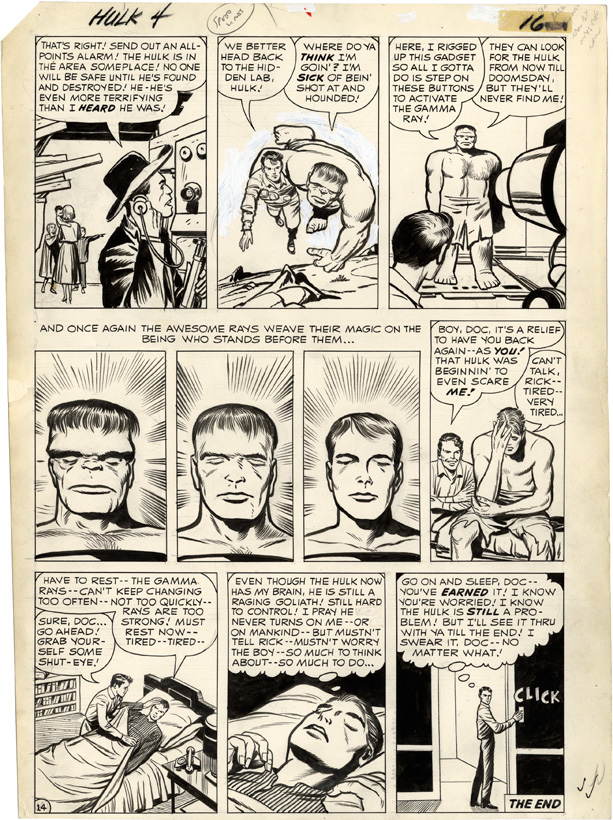
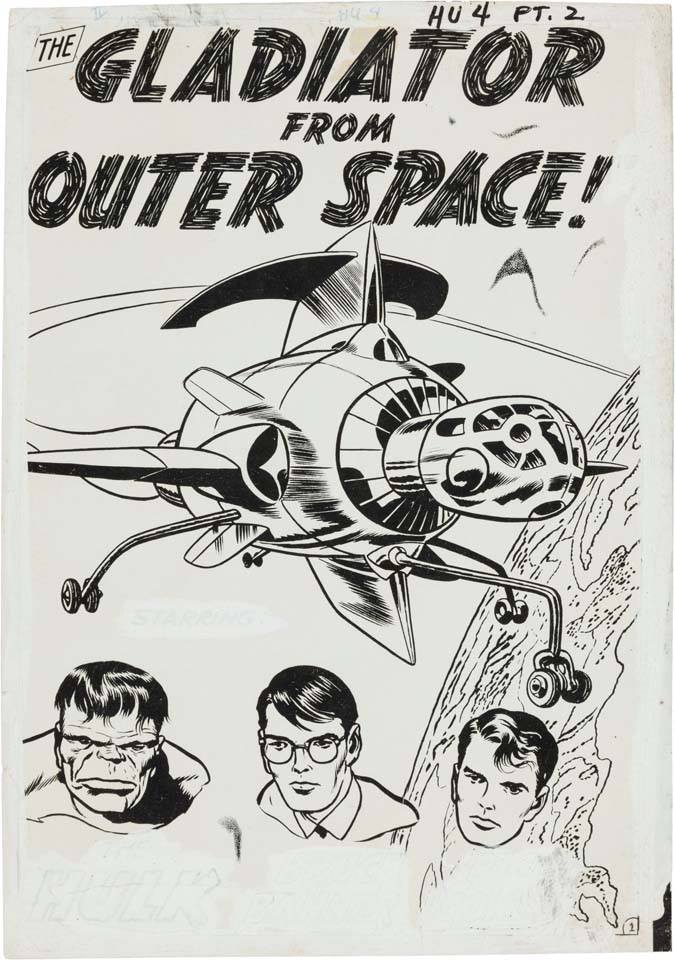
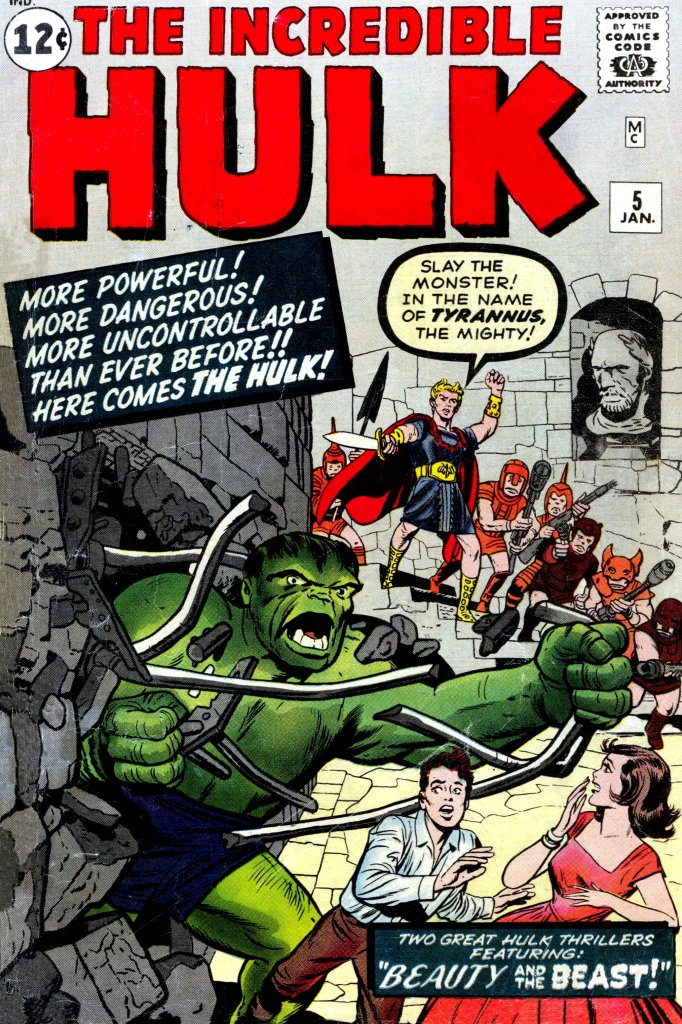
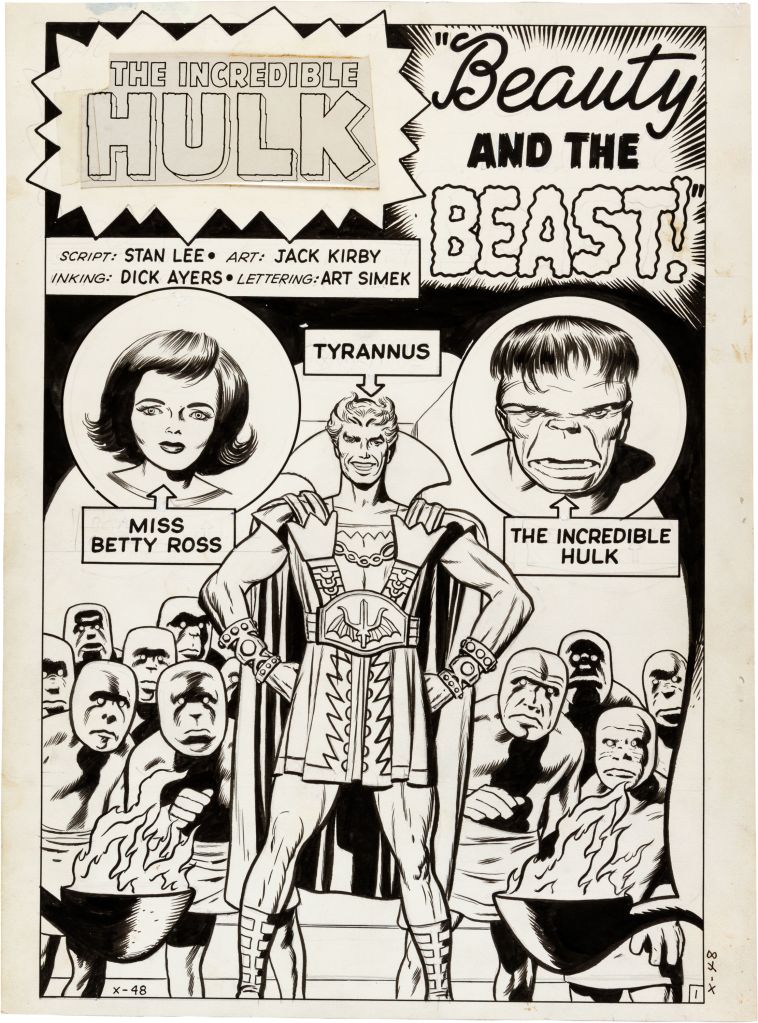
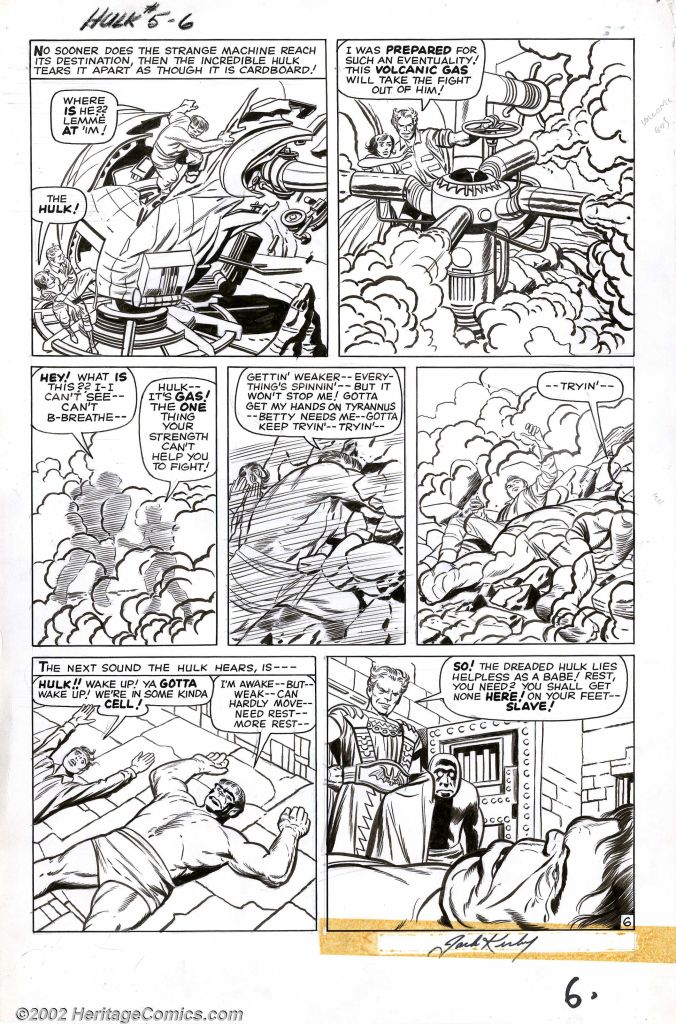
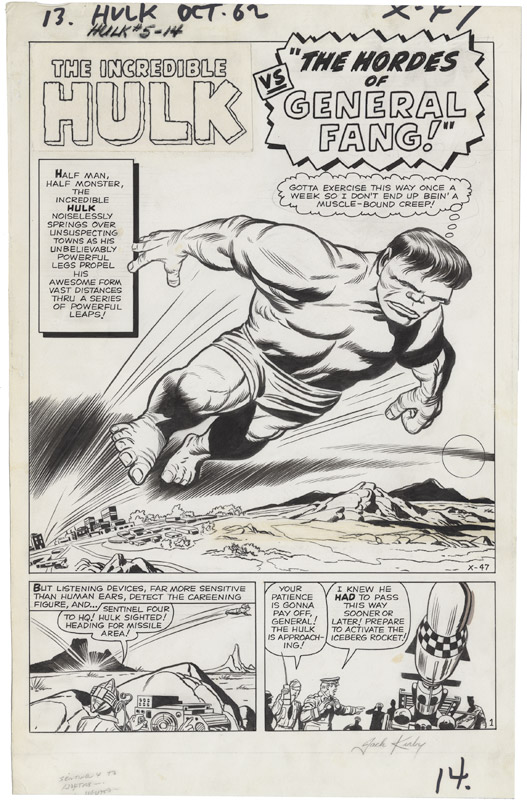
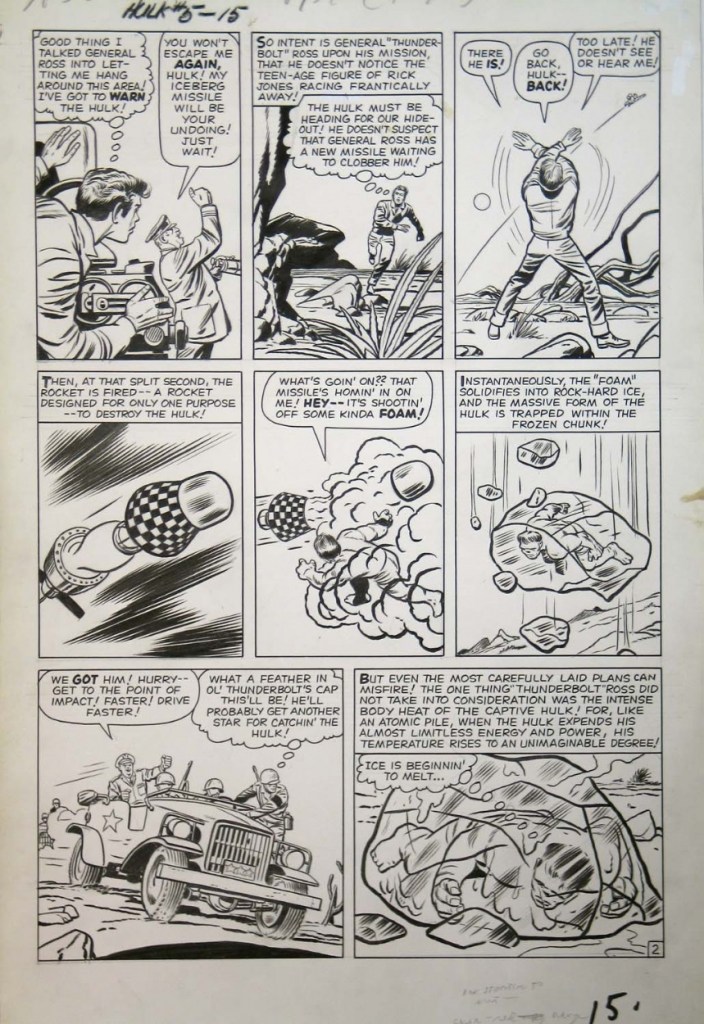
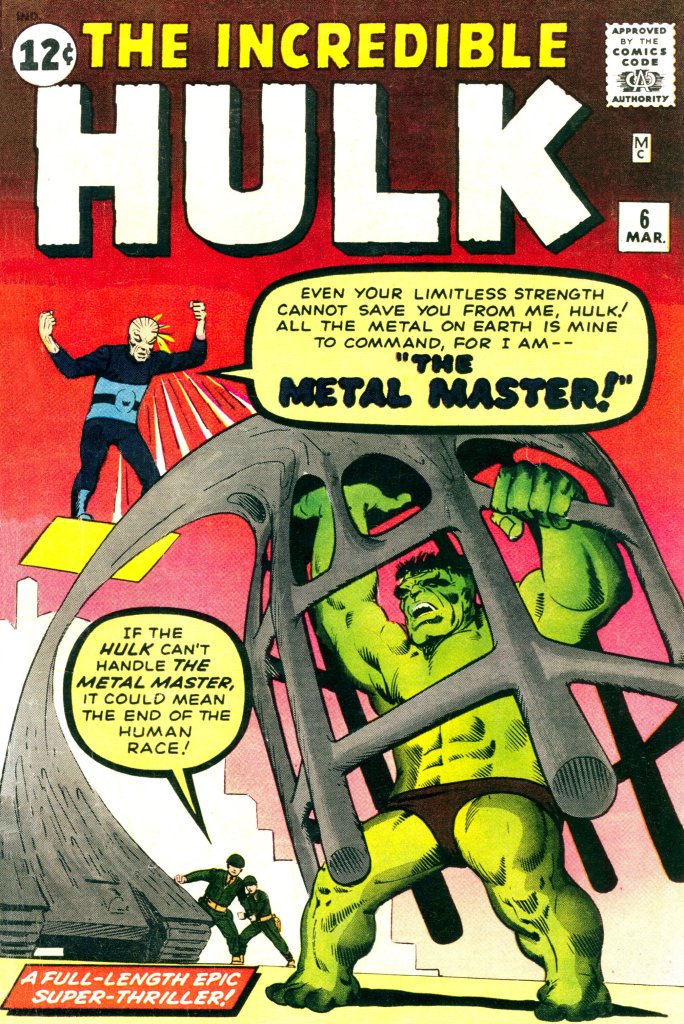
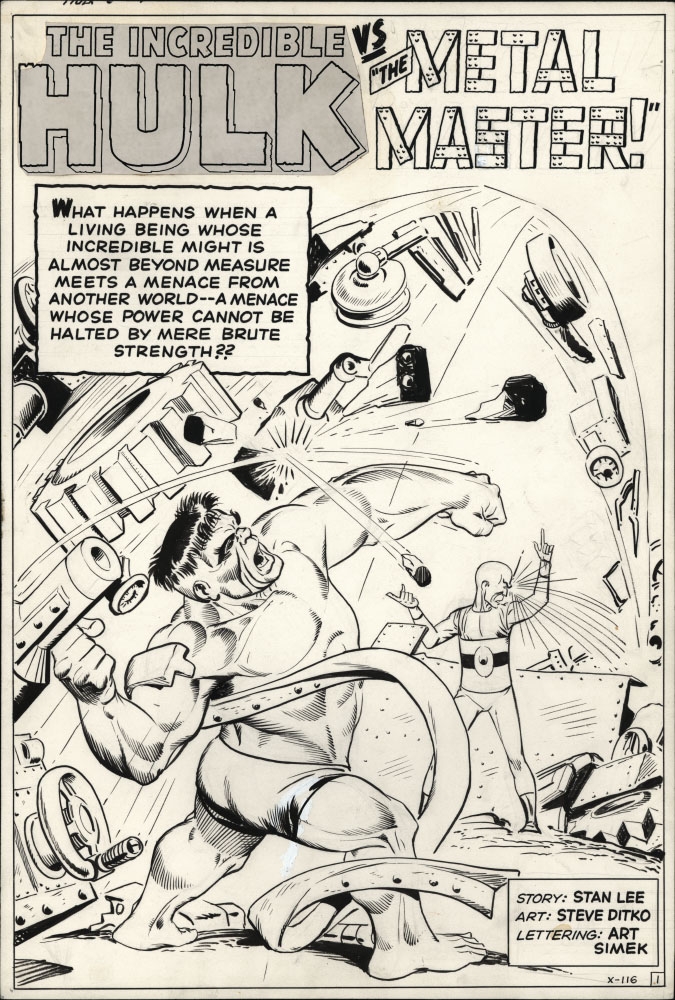
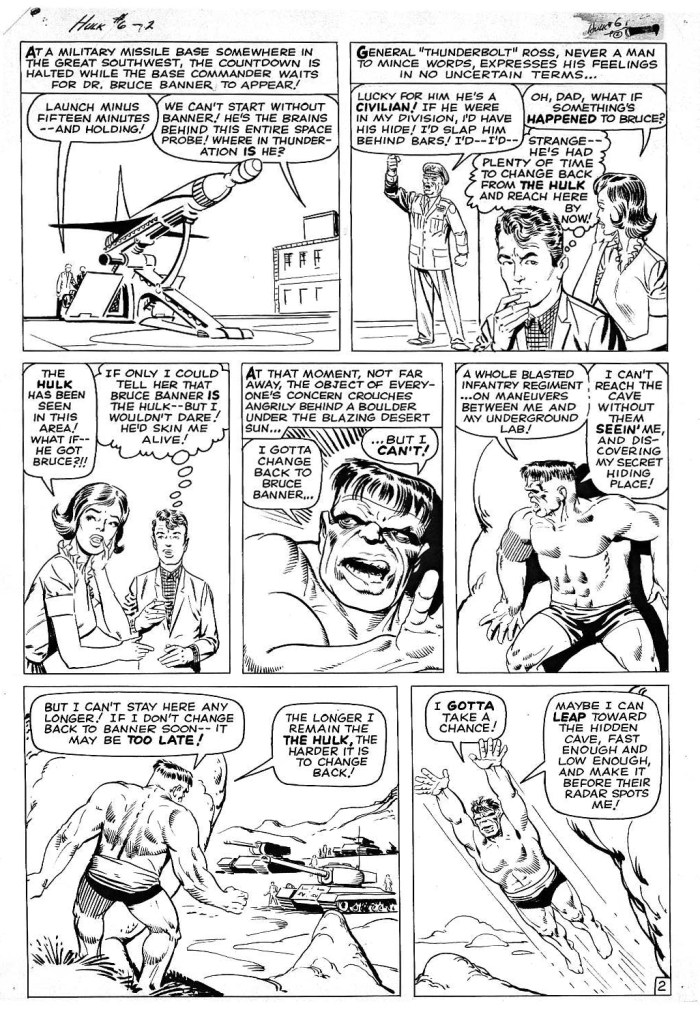
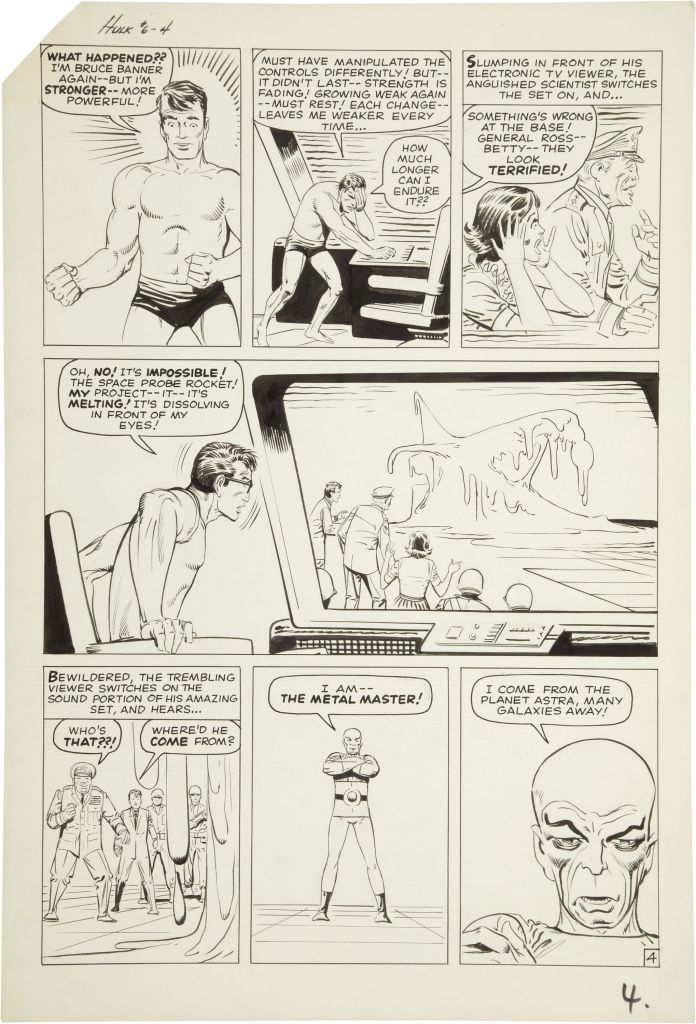
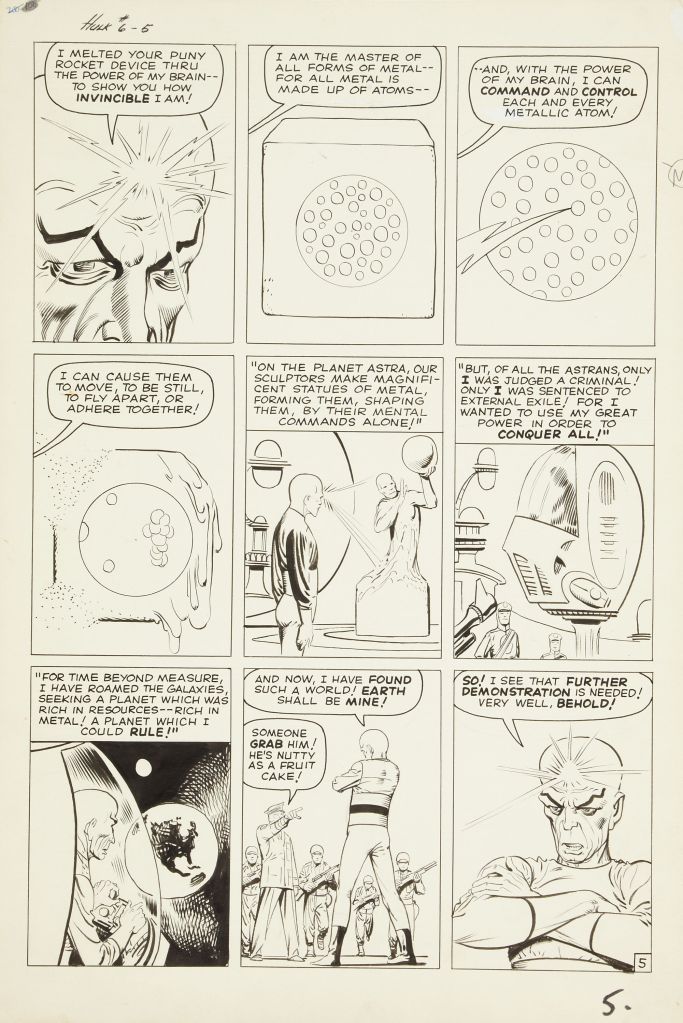

Tom:
It’s Richard Howell typing here. I’ve been enjoying your overviews of early Marvel comics, but I find myself incapable of responding to any of your posts. Can we solve this problem (without my having to learn anything new, of course)?
>
LikeLike
Richard, the first time you post a response here, I need to approve it before it automatically goes live. After that, your posts should be automatically approved. So you should be set.
LikeLike
This is the first time I’ve heard these theories as to the gray/green coloration. I had always heard it was due to the printer not being able to hold a neutral gray color. Was that always just supposition?
LikeLike
Yes, that doesn’t really track at all. Just looking at the pages from issue #1 refutes it completely.
LikeLike
Stan Goldberg (the colorist) did talk about the Hulk’s in an interview in Alter Ego 18, October 2002. When asked if green was his preferred original color for the character (bearing in mind he was usually the one who decided these things) he replied:
“I’m not certain, but it probably was. The Thing was orange, so we couldn’t use that. I certainly didn’t plan to make him red, and we kicked around the idea of making him green, but Stan wanted to try gray. I fought him on that. I told him it wouldn’t work, and it didn’t work, because we couldn’t keep the color consistent throughout the book. Sometimes the Hulk was different shades of gray, and even green in one panel. If we hadn’t make the Thing orange that’d have been the perfect color for The Hulk”.
So…it does seem pretty conclusive that the long-held story about the printing problem (which I think Stan Lee also mentioned in Origins of Marvel Comics back around 1974) is true. Other theories are intriguing…but there is no reason Goldberg would have got this wrong.
LikeLiked by 1 person
@Harmony Gates: Your reference to Stan Goldberg is interesting — thanks for sharing!
I have a lot of experience as a print designer with numerous press checks under my belt. I know from experience that neutral colors can drift quite a bit on press — just a little gain in one plate can give something a noticable color cast. So I’m sympathetic to the argument.
This (https://legionofandy.com/2021/04/06/ben-day-dots-part-9-1950s-to-1980s/) is a fascinating article that breaks down how YRB watercolor mixes were used as color guides for the CMYK separators — and they actually talk about how Mjolnir’s gray was indeed made up of multiple plates.
But that also undermines the argument a bit. If they had a formula for reproducing Mjolnir on a regular basis (to say nothing of DC cranking out Batman’s gray costume for decades), why would a gray monster be such a problem? The gray didn’t even last a second issue, so its not like they were wrestling with the problem over a series of months until they threw up their hands in desperation and gave in to the fairly drastic solution of “let’s just make him green!”
I don’t think Stan Goldberg is trying to misrepresent anything, but knowing how memories can be tainted over the years, I’m having a hard time squaring the claim with what we know of the greater industry at the time.
LikeLiked by 1 person
@Harmony Gates Yes, that’s fascinating, in that the very minor but nonetheless perceptible differences of gray in Hulk #1 might conceivably bother a professional colorist much more than anyone else. Rather than this being a case of the issue comes back looking like mud, it sounds more like the company colorist thought gray was a bad choice overall, and in retelling the printing quality reason might have gotten mixed in with a reason that the main character looks drab.
That is, it can both be true that 1) Goldberg thought the variation was not acceptable, and 2) While that particular variation result didn’t bother anyone else, it was generally agreed the color shade wasn’t looking good e.g. being too dull. Thus they changed the Hulk’s color in the next issue. Depending on how strongly Goldberg made his objections about the shading specifically, people might remember that primarily, even if objectively it was just him being extremely fussy.
LikeLike
I love this Kirby Hulk. It may be my favorite Hulk.
LikeLike
I suspect they were still tinkering with the Hulk when Avengers #1 hit the stands. There’s no apppearance by or reference to Bruce Banner; even Rick Jones, who was constantly around Bruce, only refers to the Hulk as the Hulk. So maybe Lee and Kirby were seeing if dropping Bruce would juice things for him.
LikeLike
Here are some quotes from Ditko that appeared in his ‘The Complete Four Page Series and Other Essays’ compilation published in 2020, relating to the Hulk #6 with the Metal Master:
“Stan provided a brief treatment of the story and he and I discussed the story idea. I worked out the visual story, supplied all the necessary details and fill-in material for the 24-page story.
I delivered the art and rough script pages and Lee and I went over every page and panel for clarification, how I followed the synopsis, added to it or changed it and why. Any necessary corrections were made in the page margin to be done after Stan added dialogue and the pages were lettered. I inked the story.”
Ditko also wrote about his work with Lee on re-launching the Hulk in Tales to Astonish. Here are some quotes from the Ditko/Snyder article ‘And Lo There Was a Hulk’ (reprinted in ‘Complete Four Page Series and Other Essays by Steve Ditko’, 2020).
“We had been producing Spider-Man and Dr Strange and both features were doing ok. Now Stan wanted me to do another character or series”
“I was interested in working up an idea on my own as I did with Dr Strange, again for the sake of variety. I intended to do a hero in street clothing to avoid special costume changes.”
(Ditko explains that Lee offered him Daredevil – which Ditko declined because he didn’t like the cane gimmick – and Iron Man, but Ditko didn’t find the heart gimmick ‘interesting enough’. Then Lee provided him with a list of choices – Kazar, Sub-Mariner, Hulk ‘and other oldies’. Ditko chose the Hulk because the military angle made it different…and put aside his ideas for a completely new feature)
“There were discussions between us about the second Hulk. A big part centred on what Stan wanted to discard, what we could keep and why.”
“The military context would remain with the supporting cast of General Ross and his daughter. The aliens, monsters, out-sized villains in far out fantasies, were scrapped as junk material. The more human-type of villain, meaning the less super-powerful in contrast to the Hulk, were in. It meant scaling down the potential for dramatic visual hero/villain action. So, the more possible, logical, believable – a ‘realism’ – was definitely in.”
“Spider-Man would be mined for the ore/ideas that could blend in with the Hulk. Since the Parker/Spider-Man was working successfully, Stan believed that was the direction to go with Banner Hulk”
“So there would be more emphasis on showing the psychological, social problems of Banner and his role as the Hulk and how it affects his relationship with others and with his life and the world”
“There came the usual Lee plot synopses, my working out the story pages / panel breakdowns, pencilling of the art, rough script, and then going over the material with Stan. But I wouldn’t be inking the second Hulk. It may have been because I didn’t believe I could do it each month along with Spider and Strange”. (Elswhere in his essays Ditko clarifies that he wrote rough notes ‘merely as a guide’ for Lee – who wrote the actual dialogue)
LikeLiked by 1 person
All this talk about early comic book coloring got me looking at old issues of Spider-Man.
Wherin I learn that from ASM #1 to ASM #4, Spider-Man’s costume was red and MAUVE!
Mind. BLOWN.
Mauve. Tell me that’s not a great bar bet with a comic book nerd.
LikeLike
Looking over a scan of Hulk #1, the gray does seem to drift a little bit in places. There’s a noticeable difference on page 9 versus page 10. But it’s hardly a major issue. I can’t see it would be deemed unacceptable, especially by the standards of the time.
Page 18, middle (panel 5), is the panel where the Hulk is green. However, that looks to be a deliberate coloring choice for dramatic effect, not a printing error. Just like his hands are yellow on page 18 top (panel 2). Similar to page 19, middle (panel 6). There might be a little truth to the coloring story in that the page 18 middle panel could’ve caused somebody to say the green appearance works better. But indeed, the whole story itself doesn’t seem to hold up.
Overall, I think the problem is that here the Hulk looks dull and drab. It’s great for a one-off “monster” story, or the “horror” genre. But for a continuing series of “action” stories, it does seem likely someone thought a brighter color was necessary.
LikeLike
Hadn’t previously heard Kirby’s version of the behind-the-scenes origin of the Hulk, but it certainly makes more sense than the Lee’s version in Origins of Marvel Comics and I’d wondered why the 2nd ongoing series of the new Marvel era featured a character who was much more of a monster than a super-hero. Sure, there was the example of the Thing, but he was part of a team and while potentially brutal retained some self-control, while the early Hulk was even more brutal. Read the Midnight Monster tale on the other post, first time I’d read that too, and I can definitely see the similarities and it makes sense that Kirby would suggest doing an ongoing series of such a character, albeit tweaked enough so that the human side of the monster was much more sympathetic than the narcissistic creep who willingly transformed himself into a monster with the intent to commit murder.
Also, seems that with all their short-monster stories, Marvel had already been following the horror movie trend for several years by 1962 and even the radiation bit was borrowed from monster movies of the ’50s, such as the original Godzilla. Lee just found it a very convenient means to give his characters various powers.
Also fascinating how although the Hulk was very much a Kirby creation, Ditko significantly fine-tuned the creation with the introduction of the anger factor, such that it became a permanent key aspect of the Hulk’s character.
LikeLike
I would not call Hulk a failure just because his series lasted only 6 issues. Marvel was restricted on how many titles they could publish, and they had other things they wanted to release. I think if you map it out, Hulk appeared on the newsstand every month in one title or another until he got his ongoing series in Tales To Astonish #59/#60. He might have missed one month at most.
Just because the numbering ended, Stan never quit using the character and always knew he’d be bringing him back.
Stan Lee himself said in a video interview that the grays were inconsistent in issue #1 so they opted to go with green instead. I wish I could remember where I saw the interview, but it’s online somewhere.
LikeLike
“Hulk appeared on the newsstand every month in one title or another until he got his ongoing series in Tales To Astonish #59/#60. He might have missed one month at most. ” More like six between his cancellation and Avengers #1. Even after that it was off-and-on before he wound up in Tales to Astonish.
LikeLike
How did I forget to mention this? There’s a 1957 movie, “The Amazing Colossal Man” that looks a lot like it might have inspired the Hulk: soldier rescues a man from nuclear test site, gets radiation exposure (a nuclear scientist’s explanation how the guy survived amounts to “he got lucky”) and finds himself growing into a powerful giant. Eventually he goes berserk. Combine that with Jekyll/Hyde and you’ve got the Hulk.
LikeLiked by 1 person